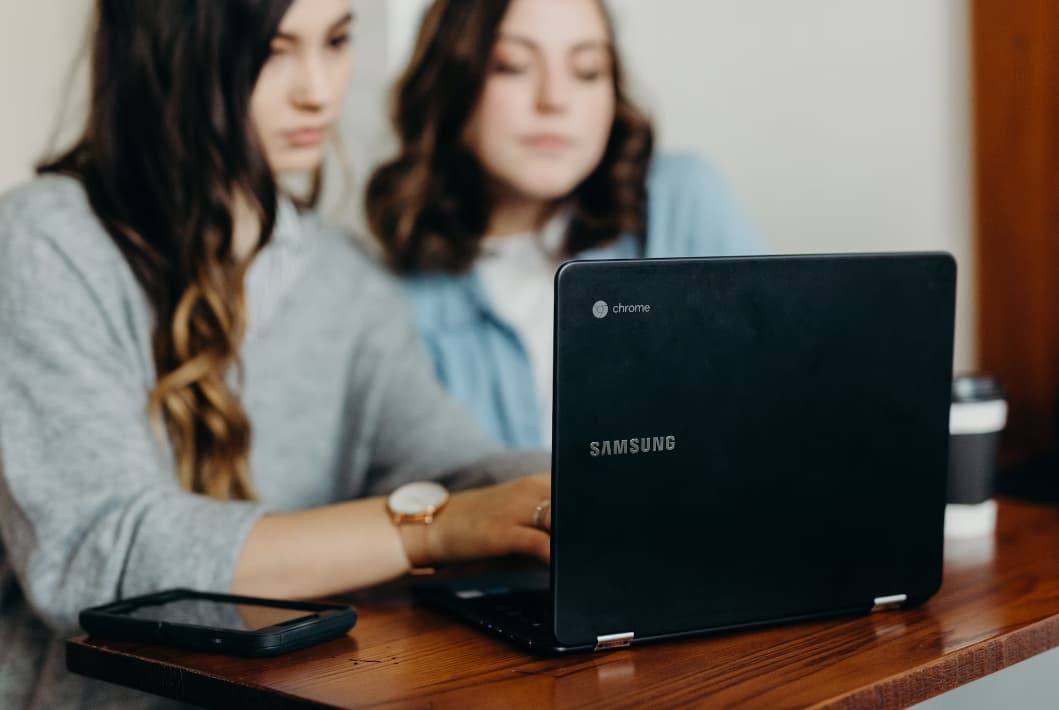We’ve all been there – you go to turn on your trusty Chromebook, ready to get some work done, and nothing happens. The screen remains ominously black no matter how many times you press the power button.
Don’t panic! There are several troubleshooting steps you can try to resurrect your device.
Chromebook Won’t Turn On

Why Your Chromebook Might Not Be Turning On?
Before jumping into solutions, let’s first go over some of the possible reasons why your Chromebook is refusing to start up:
- Faulty charger or loose cable connection – Make sure the charger is plugged securely into both the wall outlet and your Chromebook. Try wiggling the cable at both ends to check for a loose connection.
- Drained or degraded battery – Over time, lithium-ion batteries lose capacity. If your battery is worn out, your Chromebook might turn on briefly then shut off.
- Damaged operating system – Corrupted system files could be preventing Chrome OS from loading properly. This often occurs after a bad update or improper shutdown.
- Faulty hardware – In rare cases, an internal component like the motherboard or screen fails. This requires professional repair or replacement.
- Stuck brightness settings – Chrome OS has a quirk where setting screen brightness to minimum turns off the display, making it seem like the laptop is off.
- External accessories – Malfunctioning USB devices, SD cards, etc could be stopping the boot process.
Now let’s go through some troubleshooting steps to identify and resolve the issue.
Basic Troubleshooting to Try First
Before concluding your Chromebook is beyond saving, there are some basic things you should check:
Inspect the Charging System
The first thing to check is whether your Chromebook shows any signs of life when plugged in?
- Plug the charger directly into the wall outlet rather than a power strip, which could be faulty.
- Ensure the charger and USB-C cable are inserted fully into both the Chromebook and wall outlet.
- Wiggle the connections to check for anything loose. Bad connections can prevent charging.
- Try charging for at least 30 minutes to rule out an exhausted battery.
- Inspect the charging port and cable for damage or bent pins.
- If possible, attempt charging with a compatible charger from another device. This will reveal if the issue is the Chromebook or the charger.
Many Chromebooks have an LED near the charging port that illuminates when power is received. If this light is on, continue troubleshooting. If not, the issue is likely a faulty power supply.
Check Battery Health
A degraded lithium-ion battery with reduced capacity could explain why your Chromebook briefly powers on and then shuts down.
You can analyze the battery health by:
- Booting into Chrome OS, if possible. Then open the app launcher and go to Diagnostics > Battery Health.
- Removing the battery and checking its manufacturing date. Batteries degrade over time.
If the battery capacity is at 70% or less, consider replacing the battery through the manufacturer.
Remove Peripherals and Accessories
If you have any external devices plugged into your Chromebook like a USB drive, headset, or SD card, disconnect them. In rare cases, a faulty peripheral can prevent booting.
Reboot after removing all accessories and see if anything changes. If it powers on, plug devices back one at a time to identify any problematic hardware.
Adjust Screen Brightness
Here’s an easy thing to check – toggle your screen brightness up and down a few times. As mentioned earlier, Chrome OS has a peculiarity where minimum brightness turns off the display completely. This tricks some users into thinking their laptop won’t turn on!
Press the brightness up key several times just in case. You may be pleasantly surprised to see it spring back to life.
Powerwash Your Chromebook
If you’ve tried the basic steps and your Chromebook still fails to boot, the next troubleshooting option is a factory reset, also known as a powerwash.
Powerwashing completely erases and reinstalls Chrome OS. This will wipe all local files and restore your Chromebook to out-of-the-box condition. However, files saved to cloud storage like Google Drive will remain available once you sign back in.
Steps to powerwash a Chromebook:
- Charge your Chromebook for at least 30 minutes, until the low battery icon disappears after powering on. This ensures it doesn’t run out of juice mid-reset.
- Access the settings menu by selecting the time icon in the lower right corner, then the gear icon.
- Go to Advanced > Reset Settings.
- On the reset screen, click Reset to initiate a factory reset.
- The device will reboot into recovery mode to reinstall a fresh Chrome OS. Follow the on-screen instructions.
- After 10-15 minutes, power wash will be complete. Sign back into your Google account to restore synced data.
Powerwashing troubleshoots software issues, corrupted OS files, bad updates, and improperly shut down Chromebooks. There is a good chance this will resurrect your device!
Recover Chrome OS Using External Media
If you’ve tried both basic troubleshooting and a powerwash, the Chromebook likely has a deeper issue beyond corrupt files. The next step is to recover the operating system via external media, completely reinstalling Chrome OS.
Here is how to recover Chrome OS:
- On another computer, visit https://chrome.google.com/webstore and install the Chromebook Recovery Utility.
- Insert a 16GB+ USB flash drive or SD card into the computer. Warning: All data will be erased!
- Open the Recovery Utility and click Get Started.
- Select your Chromebook model then the inserted media. The utility will download and write the recovery image.
- Once complete, remove the media from the computer.
- Insert the media into the non-working Chromebook. Power on and hold Esc + Refresh, then tap Power. This boots into recovery mode.
- The recovery media will automatically run, reformatting the drive and installing a fresh OS. Simply follow the on-screen directions.
- After recovery is complete in 10-15 minutes, remove the media and restart your Chromebook normally.
Recovering via external media often resolves tricky startup issues by completely rewriting the operating system. This should get your Chromebook up and running again.
Hardware Repair or Replacement
If you have exhaustively tried the above troubleshooting tips with no success, the issue likely stems from a hardware malfunction – the root cause of a Chromebook refusing to power on or boot.
Here are some things to consider:
- Screen – Does the screen remain black when powering on or does it display anything? If completely black, the display, cables, or connectors could be defective.
- LED indicators – Does the battery/power indicator light up when connected to power? If not, the motherboard or internal cables may need professional repair.
- Power button – Does pressing the power button elicit any response? If unresponsive, the switch or board is likely faulty.
- Corrosion – Look inside ports and connectors for any gunk, debris, or liquid damage. Corrosion can disrupt power and data flow.
- Posts/Boots intermittently – If your Chromebook starts up only sometimes, components like memory or storage could be failing.
- Beeping sounds – Listen closely on bootup for any audible beeps. This clue you into specific hardware issues the Chromebook has detected.
For suspected hardware defects, contact the manufacturer or a local repair center for professional service and replacement of damaged parts. Some common repairs include:
- Screen and display cables
- Charging port replacement
- Power switch or button
- Motherboard replacement
- Battery replacement
- Memory and SSD upgrades
If your Chromebook is out of warranty, the repair cost may exceed the value of the device. In that case, consider putting the money towards a new Chromebook rather than sinking funds into an aging one.
FAQs and Precautions
Here are some commonly asked questions and tips regarding reviving an unresponsive Chromebook:
How do I enter recovery mode on tablets or old Chromebook models?
- For tablets, hold Volume Up + Power for 10 seconds
- On older models, press a physical recovery button on the back or underside. This automatically boots into recovery mode.
Can I recover without a USB drive?
- Newer Chromebooks released after April 2022 support cloud recovery over the internet. Connect to WiFi and select “Recovery using Internet connection”.
What if my Chromebook turns on but shuts down after a few minutes?
- This points to a battery issue. Check battery health via the Diagnostics app and consider replacing the battery if capacity is below 70%.
Will powerwash or OS recovery delete my local files?
- Yes, so be sure to back up any local data you want to keep. Files synced to cloud drives like Google Drive will be restored once you sign back in.
My Chromebook charges but the battery won’t hold a charge. Why?
- Fully charging and then completely draining a Chromebook battery helps recalibrate it. Do this a couple of times to see if it resolves any battery issues.
Why does my Chromebook randomly shut off sometimes?
- Random power offs are another indicator of a bad battery. Other causes can be overheating or motherboard failure.
Also Check: ERR_SSL_VERSION_INTERFERENCE Chrome Error
Conclusion
Chromebooks are generally durable and reliable, but they can stop working just like any other computer. With the right troubleshooting approach, you can often get your device powered back on and usable again.
Start with basic steps like charging, removing peripherals, and doing a factory reset. If these initial options fail, use recovery media to cleanly reinstall Chrome OS.
For hardware defects like a cracked screen or unresponsive motherboard, seek professional repair or replacement. While not impossible to fix, severe hardware issues typically require technical skill to mend.
With some perseverance and patience, there’s a good chance you can resurrect your Chromebook. But if all else fails, it may be time to replace your trusty companion with a newer model. Just be sure to back up the data beforehand!
Let me know if you have any other questions! I’m happy to provide more details about troubleshooting specific Chromebook issues.



